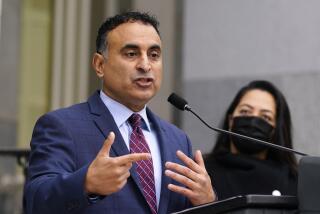Editorial: Data on officer-involved shootings will finally get compiled under state and federal laws
- Share via
Was 2015 a particularly bad year for police shootings? Were unarmed African American men disproportionately killed in encounters with police? Or did it just feel that way thanks to the newfound attention being paid to officer-involved shootings since 18-year-old Michael Brown was killed on a Ferguson, Mo., street in August 2014?
Unfortunately, the answer to those questions are elusive. The data required to prove or disprove theories spun by protesters, politicians or police are not available. Until recently, it wasn’t routine for police departments or state or national agencies to gather and release information about the use of deadly force.
The latest version of the law is superior to its predecessor in that it has teeth, albeit not terribly sharp ones.
Thankfully, that appears to be changing. In December 2014, while protests continued over the death of Brown and others, including Ezell Ford in Los Angeles, Congress finally passed the Death in Custody Reporting Act of 2013, a reauthorization of an expired 2000 law that Rep. Robert C. Scott (D-Va.) had been pushing for years.
The latest version of the law is superior to its predecessor in that it has teeth, albeit not terribly sharp ones. States that do not comply with the requirement to report annually on people who die while being arrested or in police custody can lose 10% of the funding they receive under the federal Omnibus Crime Control and Safe Streets Act. It’s not a big stick, but it is an improvement over the original law, which was voluntary and simply ignored by some states.
There ought be less tolerance this time for noncompliance. In February, FBI Director James B. Comey lamented the lack of concrete data. “How can we address concerns about officer-involved shootings if we do not have a reliable grasp on the demographics and circumstances of those incidents? We simply must improve the way we collect and analyze data to see the true nature of what’s happening in all of our communities,” Comey said.
That sentiment resonated in California even though the state had complied with the 2000 law, and continued to do so even after the law expired in 2006. Last year, legislators doubled down on data collection with Assembly Bill 953 by Shirley Weber (D-San Diego), requiring police agencies to collect racial data on all police stops — similar to what the LAPD was required to do under the federal court-mandated consent decree that followed the Rampart scandal.
Another bill passed last year, AB 71 by Freddie Rodriguez (D-Pomona), will require California’s police and sheriff’s departments to furnish information annually to the state attorney general about race and other details in use-of-force incidents.
We also applauded California Atty. Gen. Kamala D. Harris for launching the Open Justice Web portal last year, which made state databases on police killings and arrests available to the public, and for continuing to bang the drum on police accountability.
This trend may continue in 2016 if the FBI follows through on a proposal to expand the data it collects on use-of-force incidents to include nondeadly encounters.
It will still be a couple years at least until these laws and initiatives translate into solid data that can fully answer some of the bigger questions about race and policing. But one thing is already settled: Counting police killings is finally a national priority.
Follow the Opinion section on Twitter @latimesopinion and Facebook
More to Read
A cure for the common opinion
Get thought-provoking perspectives with our weekly newsletter.
You may occasionally receive promotional content from the Los Angeles Times.










